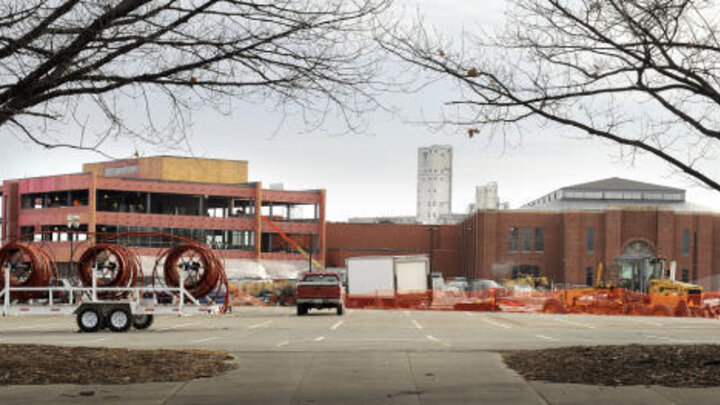First new building taking shape at Innovation Campus

The first new building at Nebraska Innovation Campus is taking shape.
Construction workers have completed much of the shell for the Companion Building, a three-story building just north of and adjacent to the former 4-H Building on what used to be State Fair Park.
They’ve also nearly finished renovating the 4-H Building, which will include a conference center and office and research space.
Renovation of the former Industrial Arts building continues at the south edge of the campus, with exterior brick walls propped up by braces and virtually nothing left inside. The university has yet to start work on a fourth building planned for the first phase of work on Innovation Campus, a laboratory between the historic 4-H and Industrial Arts structures.
University of Nebraska-Lincoln leaders, meanwhile, have decided to significantly alter the campus' design, moving greenhouses originally to be built on a new second floor of Industrial Arts to new structures to be built east of Industrial Arts. The university decided that with the Food Science and Technology Department moving into the Industrial Arts' second floor it would be awkward to have food science laboratories connected to plant science greenhouses.
“That made us rethink the whole process,” said Dan Duncan, executive director of Innovation Campus.
The move also allows the university to build greenhouses as needed rather than all at once, as would be required if the greenhouses were built on the Industrial Arts’ second floor.
He said university leaders decided private and university plant scientists won’t need as much greenhouse space as was planned for Industrial Arts.
The 250-acre, public-private research and technology park is envisioned to include more than 2 million square feet of research, meeting and office space with as many as 7,000 public and private employees working on the campus. Scott Woodbury Wiegert is developing the first phase.
The laboratory to be built and Industrial Arts will form the life sciences research center, which will house lab space for university and private researchers and startup companies.
The life sciences research center is to be completed by May 2015.
The Companion Building will house offices for Innovation Campus staff, NUtech Ventures, Industry Relations and the Daugherty Global Water for Food Institute.
Renovation and construction of the 4-H and Companion buildings is to be mostly completed by March 18, Duncan said.
ConAgra, the first official Innovation Campus tenant, plans to lease greenhouse space and do research on tomatoes and popcorn. The Omaha-based company also plans to do research on cereals on the first floor of Industrial Arts.
Duncan said the substantial completion of the first two buildings is likely to garner even greater interest among private companies that could lease space on the campus. He said three private companies are close to signing leases.
“We’ll start picking up a lot of speed here,” he said.
The $10 million greenhouse complex to be built east of the current construction site will include a head house with 30,000 square feet of space and the two adjacent greenhouses each will have 7,500 square feet.
Davis Design will design the greenhouse complex, and Sampson Construction will build it, Duncan said.
The university also is looking at building additional greenhouses that would add another 15,000 square feet, and future expansion of the head house and additional greenhouses could add another 30,000 square feet to the complex, he said.
Currently, two university plant researchers, Ed Cahoon and Harkamal Walia, plan to work in the new complex. Walia, an assistant professor of agronomy and horticulture, said he and Cahoon will use a state-of-the-art conveyor system to move plants to areas where cameras can take high-resolution images of them.
Software will then allow the researchers to study the impact daily of soil salinity and drought conditions on plants including rice, wheat and corn, Walia said. The cameras and software will allow Cahoon and Walia to see minuscule changes as the plants endure drought and high-salinity environments, he said.
Walia uses a similar conveyor and camera system in Australia to study plants remotely.
“That will accelerate one aspect of my research dramatically,” he said.
Reach Kevin Abourezk at 402-473-7225 or kabourezk@journalstar.com.